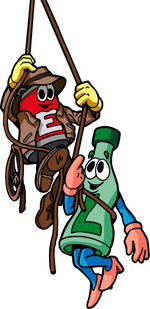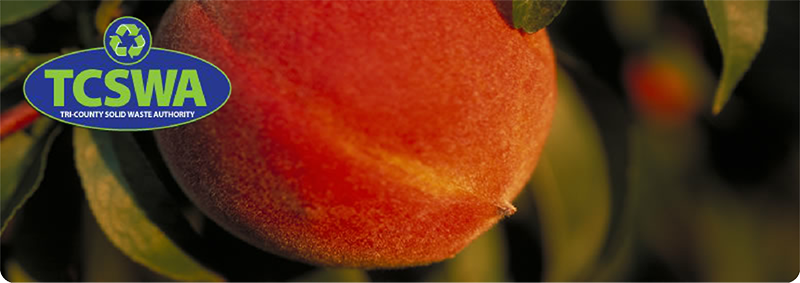Composting:
What is composting? l How can you compost? l Composting at Home
Composting Step-by-Step l Smart Gardener
What is composting?
Composting is a technique that is used to accelerate the natural decaying process. A compost pile is a collection of organic materials (materials made from plants and animals) such as leaves, yard trimmings and food scraps that will decompose over time to create compost.
Compost is the end product of the decomposition of these materials. It improves soil in a number of ways. Compost increases aeration (the ability of air to circulate), water-holding capacity and helps plants absorb nutrients.
By making your own compost pile in the backyard, you can reduce the amount of waste you send to the landfill. To learn more, click here to view the "For Your Information: How to Compost in Your Backyard" fact sheet.
How can you compost?
Backyard composting can be as basic or fancy as you like. It also depends on the amount of time and effort you want to spend as well as how quickly you want results.
Some people, for example, compost by building a wooden bin. Others take a plastic garbage can and cut the bottom out and drill holes in the side to let air circulate. Others simply purchase a factory made compost bin made from recycled plastic.
Here is a general recipe for a compost pile.
1. Find a level spot in the corner of your yard about three to five feet square.
2. Pile yard trimmings, leaves and fruit and vegetable food scraps.
3. Keep the pile moist -- not soggy -- by watering it occasionally.
4. Stir with a pitchfork or stick every few weeks to circulate air (without air, the decomposition process slows) and distribute moisture evenly. In addition, mixing your compost lets each item contribute to the decomposition process. Don’t be surprised by the heat and insects - both are part of the process. In fact, you can add red wiggler worms. They help aerate the pile and make richer compost.
When is it done? It depends. It could take several weeks to three to six months, but compost generally is done when it becomes a dark, crumbly material that is uniform in texture.
There are many groups and organizations that can help you learn how to compost. For additional information, visit Clemson University Extension Service or contact the DHEC Office (click here) or call 1-800-768-7348.
Composting at Home
Most yard trimmings can be composted including leaves, vines, plant stalks, twigs, branches and weeds (without weed seeds) to name a few. Although grass clippings can be included in this list, it's best to let them fall and decompose on your lawn -- they add nutrients to the soil. It's called grasscycling.
Food waste can be composted like fruit scraps, vegetable scraps, coffee grounds, stale bread and eggshells. In home composting bins, remember DO NOT include meat, bones, dairy or fat. These could attract pests.
This material can be composted as well -- feathers, straw, and rabbit and hamster manure (but not dog and cat waste).
This material should only be composted in LIMITED amounts -- wood ashes (a source of lime), sawdust (requires extra nitrogen -- add more food scraps), plants treated with herbicides (the chemicals need time for thorough decomposition) and shredded non-recyclable paper.
For more specific information, click here to view the "For Your Information: How to Compost in Your Backyard" fact sheet.
Composting Step-by-Step
- Fill it. Fill a bin with a mix of fresh and dry material. Always cover food scraps with leaves.
- Turn it. Composting needs food, air and water (keep it as wet as a wrung sponge). If you want compost quickly, turn it about once a week. If you don’t turn it the process will take longer.
- Use it. Use compost as mulch or soil amendment. To make potting soil, add one part sand to two parts compost.
BONUS: Add red wiggler worms. They help to aerate the pile and make a richer compost
Smart Gardening
The S.C. Department of Health & Environmental Cotrol's Office of Solid Waste Reduction & Recycling offers workshops, printed materials and other assistance on composting through its Smart Gardening Program.
One of the centerpiece efforts is "A Green Guide to Composting, Landscaping and Gardening in South Carolina". This publication focuses on many issues including soil enrichment, native planting, naturescaping, smart watering, composting and minimizing the use of chemical treatments. To view or print any of the chapters, click on a title below.
Please note that some of the files below are rather large and may require more time to download. You will need Adobe Acrobat Reader to view most of the publications below.
- Introduction to "A Green Guide to Composting, Landscaping and Gardening in South Carolina" (356 KB)
- Growing Healthy Soil (9.2 MB)
- Composting at Home (17.2 MB)
- Smart Watering (6.7 MB)
- Natural Pest, Weed & Disease Control (33.8 MB)
- The Right Plants (11.4 MB)
- Natural Lawn Care (8.5 MB)

|
